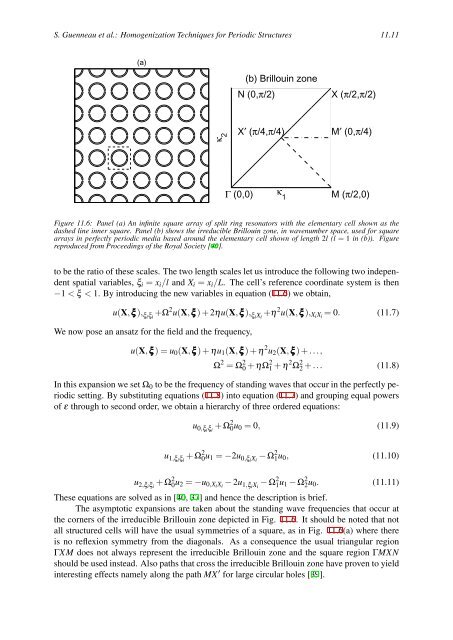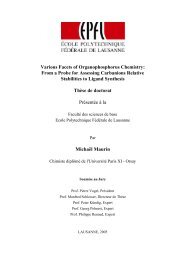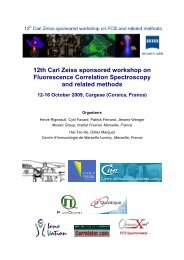GratinGs: theory and numeric applications - Institut Fresnel
GratinGs: theory and numeric applications - Institut Fresnel
GratinGs: theory and numeric applications - Institut Fresnel
You also want an ePaper? Increase the reach of your titles
YUMPU automatically turns print PDFs into web optimized ePapers that Google loves.
S. Guenneau et al.: Homogenization Techniques for Periodic Structures 11.11<br />
(a)<br />
κ 2<br />
N (0,π/2) X (π/2,π/2)<br />
X′ (π/4,π/4)<br />
Γ (0,0)<br />
(b) Brillouin zone<br />
κ 1<br />
M′ (0,π/4)<br />
M (π/2,0)<br />
Figure 11.6: Panel (a) An infinite square array of split ring resonators with the elementary cell shown as the<br />
dashed line inner square. Panel (b) shows the irreducible Brillouin zone, in wavenumber space, used for square<br />
arrays in perfectly periodic media based around the elementary cell shown of length 2l (l = 1 in (b)). Figure<br />
reproduced from Proceedings of the Royal Society [40].<br />
to be the ratio of these scales. The two length scales let us introduce the following two independent<br />
spatial variables, ξi = xi/l <strong>and</strong> Xi = xi/L. The cell’s reference coordinate system is then<br />
−1 < ξ < 1. By introducing the new variables in equation (11.6) we obtain,<br />
u(X,ξξξ ), ξiξi +Ω2u(X,ξξξ ) + 2ηu(X,ξξξ ), ξiXi +η2u(X,ξξξ ),XiXi = 0. (11.7)<br />
We now pose an ansatz for the field <strong>and</strong> the frequency,<br />
u(X,ξξξ ) = u0(X,ξξξ ) + ηu1(X,ξξξ ) + η 2 u2(X,ξξξ ) + ...,<br />
Ω 2 = Ω 2 0 + ηΩ 2 1 + η 2 Ω 2 2 + ... (11.8)<br />
In this expansion we set Ω0 to be the frequency of st<strong>and</strong>ing waves that occur in the perfectly periodic<br />
setting. By substituting equations (11.8) into equation (11.7) <strong>and</strong> grouping equal powers<br />
of ε through to second order, we obtain a hierarchy of three ordered equations:<br />
u 0,ξiξi + Ω2 0u0 = 0, (11.9)<br />
u 1,ξiξi + Ω2 0u1 = −2u 0,ξiXi − Ω2 1u0, (11.10)<br />
u 2,ξiξi + Ω2 0u2 = −u0,XiXi − 2u 1,ξiXi − Ω2 1u1 − Ω 2 2u0. (11.11)<br />
These equations are solved as in [40, 37] <strong>and</strong> hence the description is brief.<br />
The asymptotic expansions are taken about the st<strong>and</strong>ing wave frequencies that occur at<br />
the corners of the irreducible Brillouin zone depicted in Fig. 11.6. It should be noted that not<br />
all structured cells will have the usual symmetries of a square, as in Fig. 11.6(a) where there<br />
is no reflexion symmetry from the diagonals. As a consequence the usual triangular region<br />
ΓXM does not always represent the irreducible Brillouin zone <strong>and</strong> the square region ΓMXN<br />
should be used instead. Also paths that cross the irreducible Brillouin zone have proven to yield<br />
interesting effects namely along the path MX ′ for large circular holes [39].













